Analysis of Labour Market Challenges in the Australian Retail Industry
VerifiedAdded on 2022/11/18
|19
|2984
|319
Report
AI Summary
This report provides a detailed analysis of the Australian retail labor market, focusing on challenges and future trends. It begins by examining labor market data and statistics, highlighting the positive employment trends but also the rising unemployment rate. The report identifies key challenges such as increasing employee turnover, work health and safety issues, and the impact of e-commerce growth. It explores changes occurring in the past five years, including the rise of e-commerce and the need for new employee skills. Globalisation, economic structural changes, technological advancements, and innovation are discussed as drivers of these changes. The report then examines Woolworths as a case study, discussing factors impacting the company and the broader retail sector, both over the last five years and in the coming five years, based on primary and secondary research. The report concludes with insights gained from an interview with a Woolworths manager, offering a comprehensive view of the labor market dynamics and future prospects within the Australian retail industry.
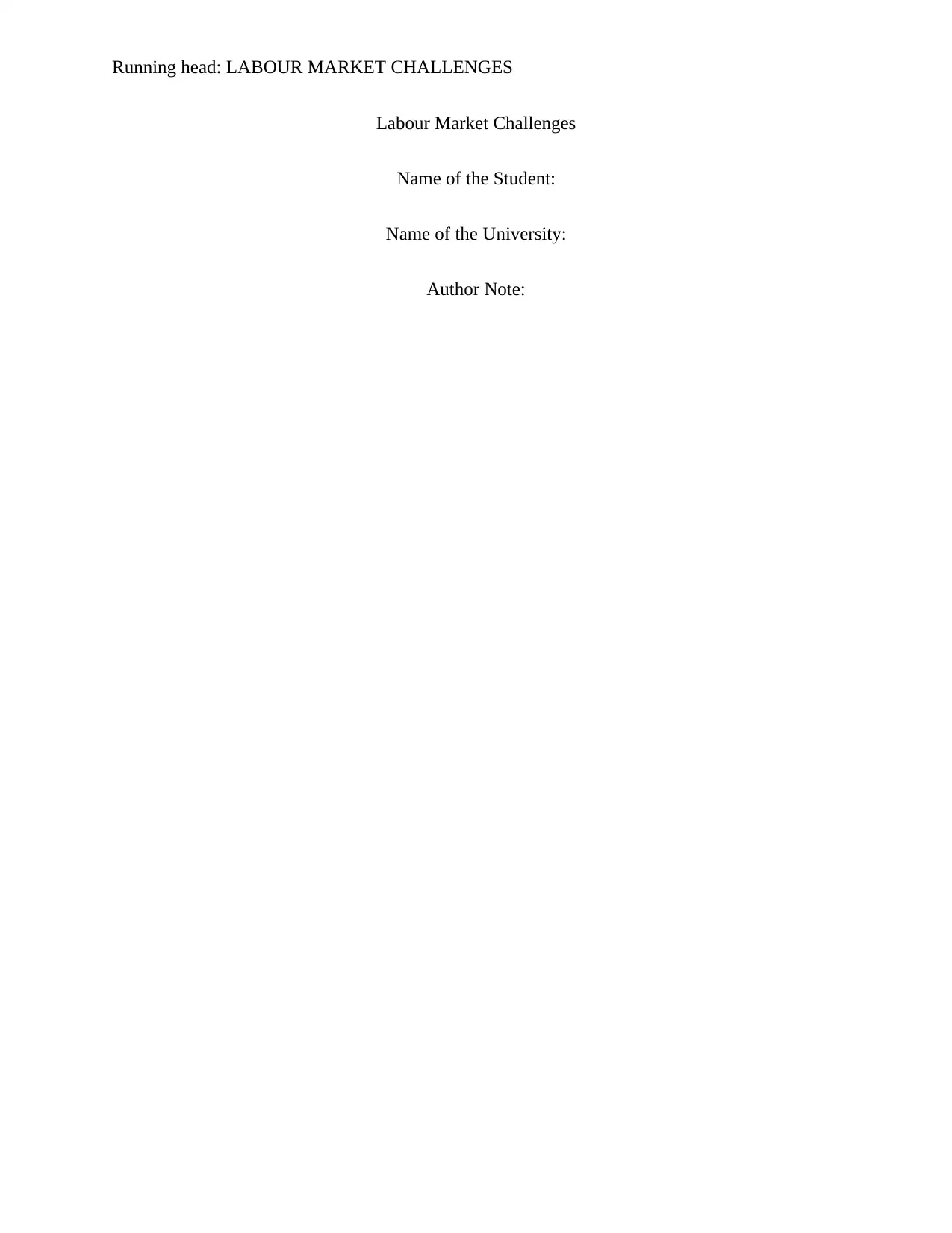
Running head: LABOUR MARKET CHALLENGES
Labour Market Challenges
Name of the Student:
Name of the University:
Author Note:
Labour Market Challenges
Name of the Student:
Name of the University:
Author Note:
Paraphrase This Document
Need a fresh take? Get an instant paraphrase of this document with our AI Paraphraser
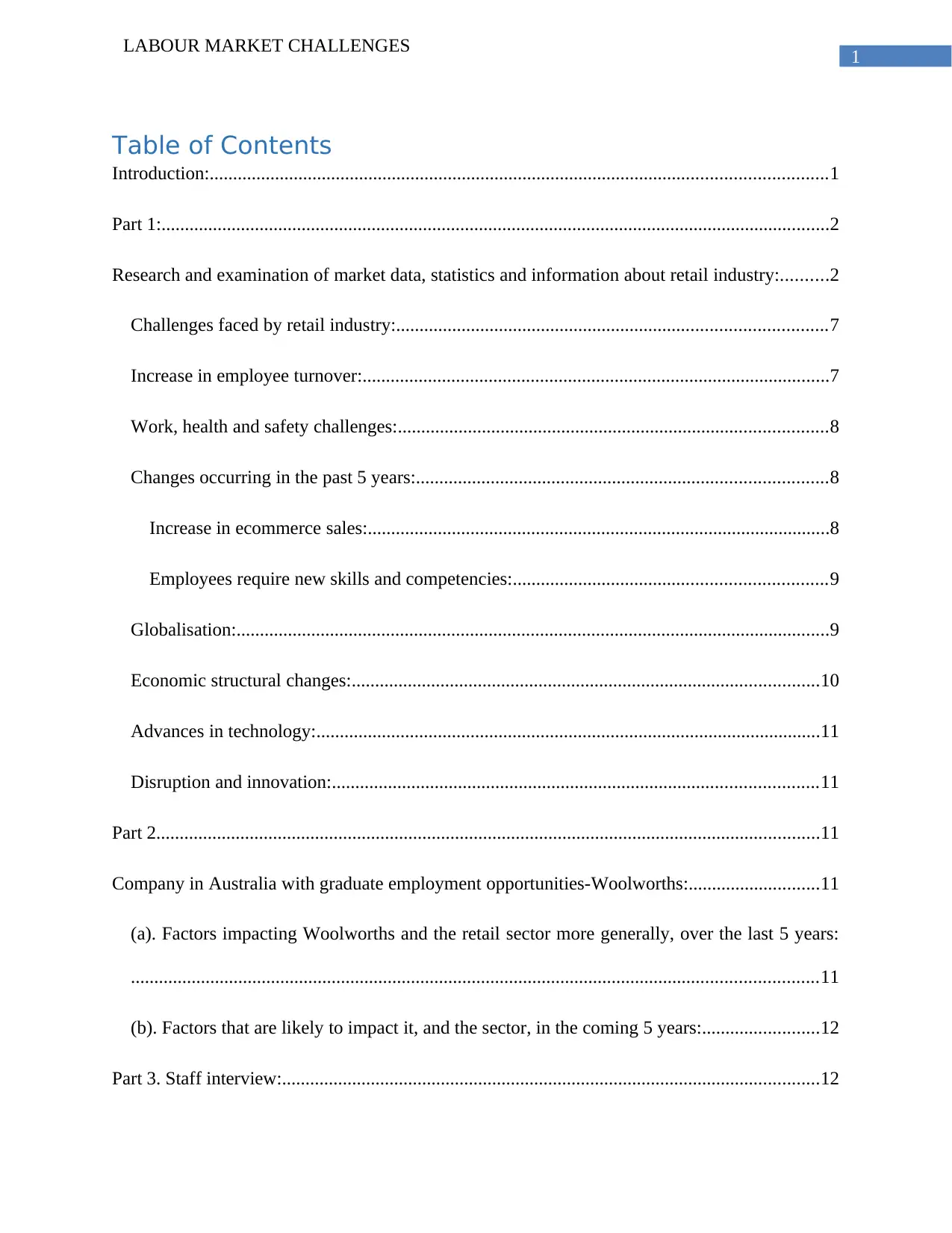
1
LABOUR MARKET CHALLENGES
Table of Contents
Introduction:....................................................................................................................................1
Part 1:...............................................................................................................................................2
Research and examination of market data, statistics and information about retail industry:..........2
Challenges faced by retail industry:............................................................................................7
Increase in employee turnover:....................................................................................................7
Work, health and safety challenges:............................................................................................8
Changes occurring in the past 5 years:........................................................................................8
Increase in ecommerce sales:...................................................................................................8
Employees require new skills and competencies:...................................................................9
Globalisation:...............................................................................................................................9
Economic structural changes:....................................................................................................10
Advances in technology:............................................................................................................11
Disruption and innovation:........................................................................................................11
Part 2..............................................................................................................................................11
Company in Australia with graduate employment opportunities-Woolworths:............................11
(a). Factors impacting Woolworths and the retail sector more generally, over the last 5 years:
...................................................................................................................................................11
(b). Factors that are likely to impact it, and the sector, in the coming 5 years:.........................12
Part 3. Staff interview:...................................................................................................................12
LABOUR MARKET CHALLENGES
Table of Contents
Introduction:....................................................................................................................................1
Part 1:...............................................................................................................................................2
Research and examination of market data, statistics and information about retail industry:..........2
Challenges faced by retail industry:............................................................................................7
Increase in employee turnover:....................................................................................................7
Work, health and safety challenges:............................................................................................8
Changes occurring in the past 5 years:........................................................................................8
Increase in ecommerce sales:...................................................................................................8
Employees require new skills and competencies:...................................................................9
Globalisation:...............................................................................................................................9
Economic structural changes:....................................................................................................10
Advances in technology:............................................................................................................11
Disruption and innovation:........................................................................................................11
Part 2..............................................................................................................................................11
Company in Australia with graduate employment opportunities-Woolworths:............................11
(a). Factors impacting Woolworths and the retail sector more generally, over the last 5 years:
...................................................................................................................................................11
(b). Factors that are likely to impact it, and the sector, in the coming 5 years:.........................12
Part 3. Staff interview:...................................................................................................................12
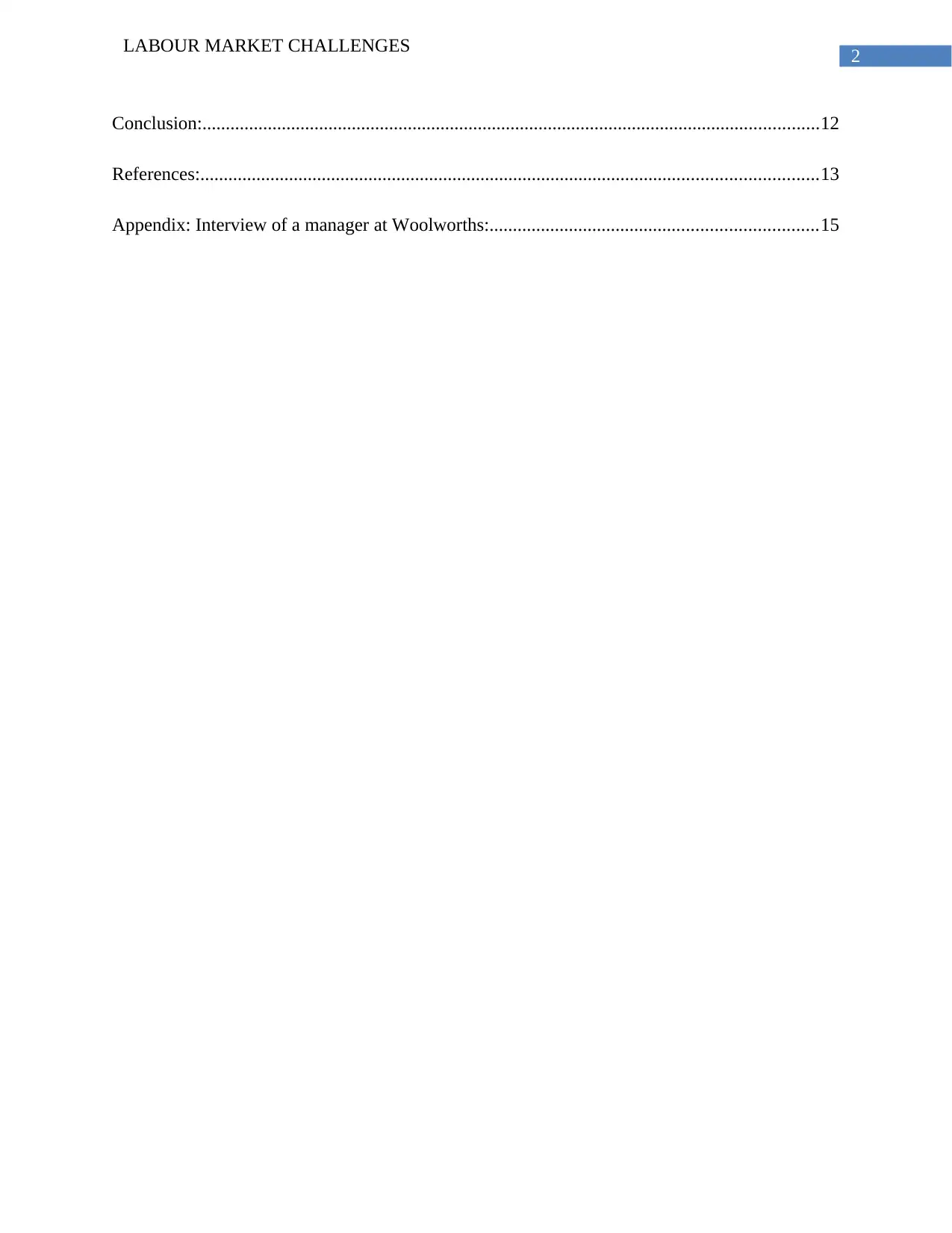
2
LABOUR MARKET CHALLENGES
Conclusion:....................................................................................................................................12
References:....................................................................................................................................13
Appendix: Interview of a manager at Woolworths:......................................................................15
LABOUR MARKET CHALLENGES
Conclusion:....................................................................................................................................12
References:....................................................................................................................................13
Appendix: Interview of a manager at Woolworths:......................................................................15
⊘ This is a preview!⊘
Do you want full access?
Subscribe today to unlock all pages.

Trusted by 1+ million students worldwide
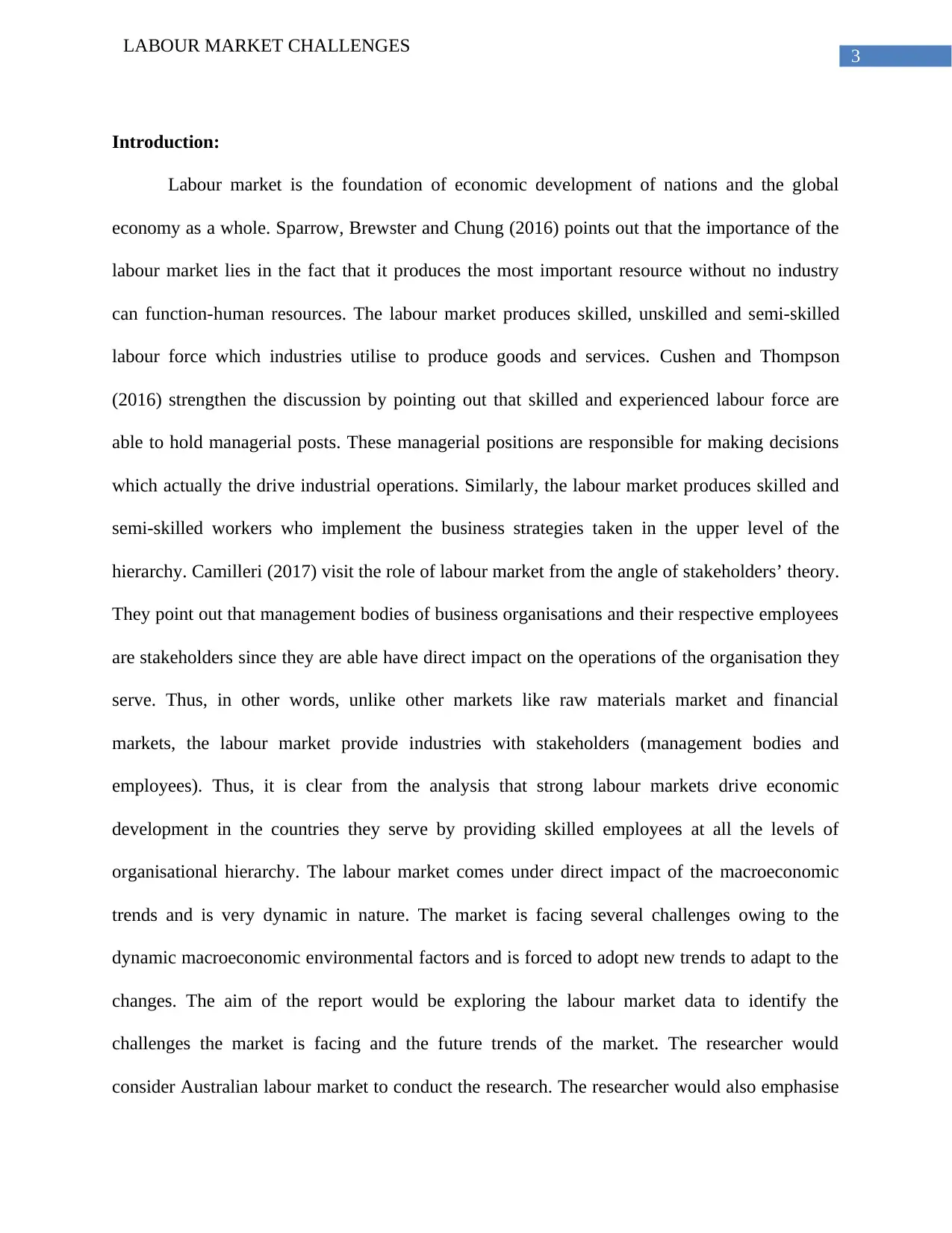
3
LABOUR MARKET CHALLENGES
Introduction:
Labour market is the foundation of economic development of nations and the global
economy as a whole. Sparrow, Brewster and Chung (2016) points out that the importance of the
labour market lies in the fact that it produces the most important resource without no industry
can function-human resources. The labour market produces skilled, unskilled and semi-skilled
labour force which industries utilise to produce goods and services. Cushen and Thompson
(2016) strengthen the discussion by pointing out that skilled and experienced labour force are
able to hold managerial posts. These managerial positions are responsible for making decisions
which actually the drive industrial operations. Similarly, the labour market produces skilled and
semi-skilled workers who implement the business strategies taken in the upper level of the
hierarchy. Camilleri (2017) visit the role of labour market from the angle of stakeholders’ theory.
They point out that management bodies of business organisations and their respective employees
are stakeholders since they are able have direct impact on the operations of the organisation they
serve. Thus, in other words, unlike other markets like raw materials market and financial
markets, the labour market provide industries with stakeholders (management bodies and
employees). Thus, it is clear from the analysis that strong labour markets drive economic
development in the countries they serve by providing skilled employees at all the levels of
organisational hierarchy. The labour market comes under direct impact of the macroeconomic
trends and is very dynamic in nature. The market is facing several challenges owing to the
dynamic macroeconomic environmental factors and is forced to adopt new trends to adapt to the
changes. The aim of the report would be exploring the labour market data to identify the
challenges the market is facing and the future trends of the market. The researcher would
consider Australian labour market to conduct the research. The researcher would also emphasise
LABOUR MARKET CHALLENGES
Introduction:
Labour market is the foundation of economic development of nations and the global
economy as a whole. Sparrow, Brewster and Chung (2016) points out that the importance of the
labour market lies in the fact that it produces the most important resource without no industry
can function-human resources. The labour market produces skilled, unskilled and semi-skilled
labour force which industries utilise to produce goods and services. Cushen and Thompson
(2016) strengthen the discussion by pointing out that skilled and experienced labour force are
able to hold managerial posts. These managerial positions are responsible for making decisions
which actually the drive industrial operations. Similarly, the labour market produces skilled and
semi-skilled workers who implement the business strategies taken in the upper level of the
hierarchy. Camilleri (2017) visit the role of labour market from the angle of stakeholders’ theory.
They point out that management bodies of business organisations and their respective employees
are stakeholders since they are able have direct impact on the operations of the organisation they
serve. Thus, in other words, unlike other markets like raw materials market and financial
markets, the labour market provide industries with stakeholders (management bodies and
employees). Thus, it is clear from the analysis that strong labour markets drive economic
development in the countries they serve by providing skilled employees at all the levels of
organisational hierarchy. The labour market comes under direct impact of the macroeconomic
trends and is very dynamic in nature. The market is facing several challenges owing to the
dynamic macroeconomic environmental factors and is forced to adopt new trends to adapt to the
changes. The aim of the report would be exploring the labour market data to identify the
challenges the market is facing and the future trends of the market. The researcher would
consider Australian labour market to conduct the research. The researcher would also emphasise
Paraphrase This Document
Need a fresh take? Get an instant paraphrase of this document with our AI Paraphraser
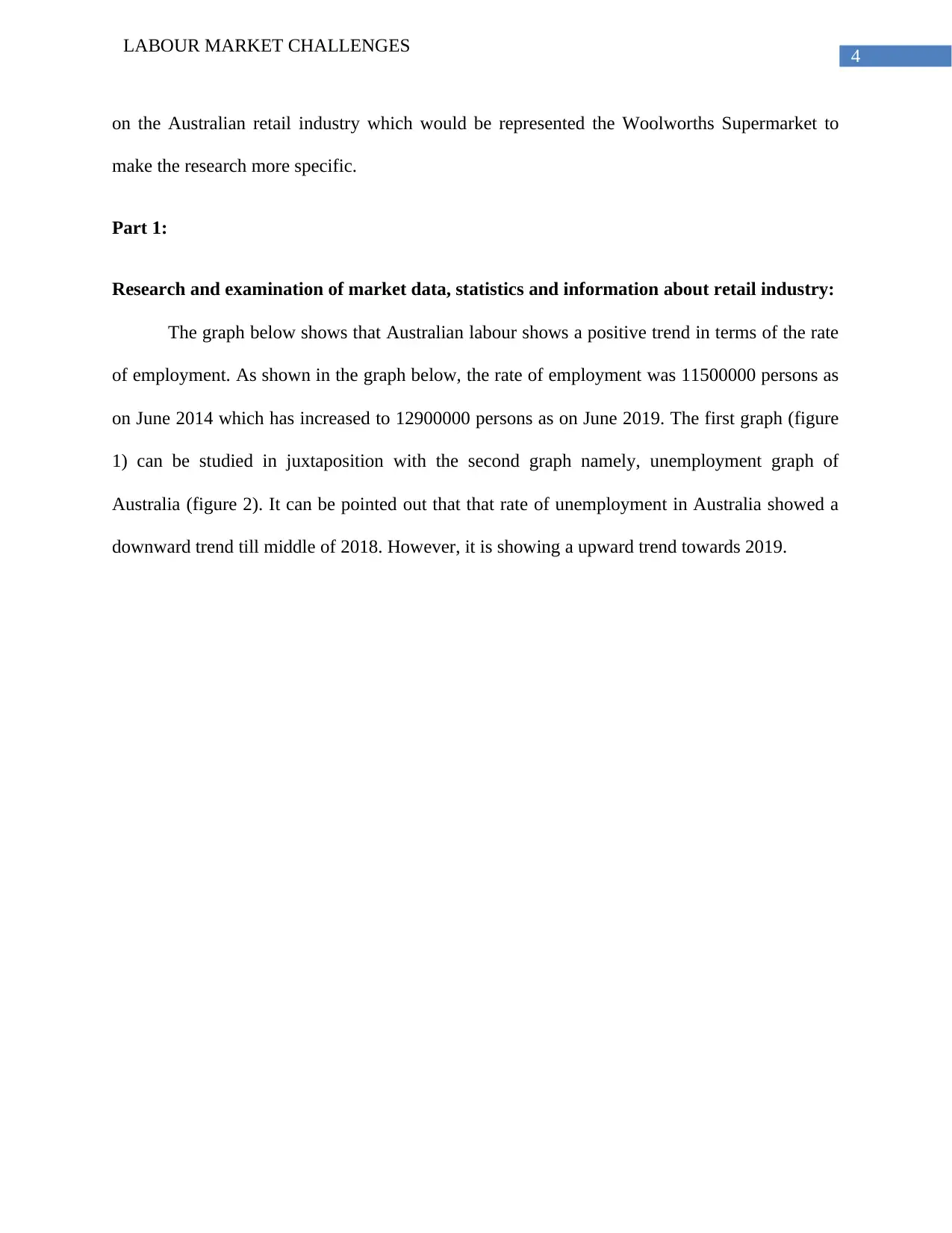
4
LABOUR MARKET CHALLENGES
on the Australian retail industry which would be represented the Woolworths Supermarket to
make the research more specific.
Part 1:
Research and examination of market data, statistics and information about retail industry:
The graph below shows that Australian labour shows a positive trend in terms of the rate
of employment. As shown in the graph below, the rate of employment was 11500000 persons as
on June 2014 which has increased to 12900000 persons as on June 2019. The first graph (figure
1) can be studied in juxtaposition with the second graph namely, unemployment graph of
Australia (figure 2). It can be pointed out that that rate of unemployment in Australia showed a
downward trend till middle of 2018. However, it is showing a upward trend towards 2019.
LABOUR MARKET CHALLENGES
on the Australian retail industry which would be represented the Woolworths Supermarket to
make the research more specific.
Part 1:
Research and examination of market data, statistics and information about retail industry:
The graph below shows that Australian labour shows a positive trend in terms of the rate
of employment. As shown in the graph below, the rate of employment was 11500000 persons as
on June 2014 which has increased to 12900000 persons as on June 2019. The first graph (figure
1) can be studied in juxtaposition with the second graph namely, unemployment graph of
Australia (figure 2). It can be pointed out that that rate of unemployment in Australia showed a
downward trend till middle of 2018. However, it is showing a upward trend towards 2019.
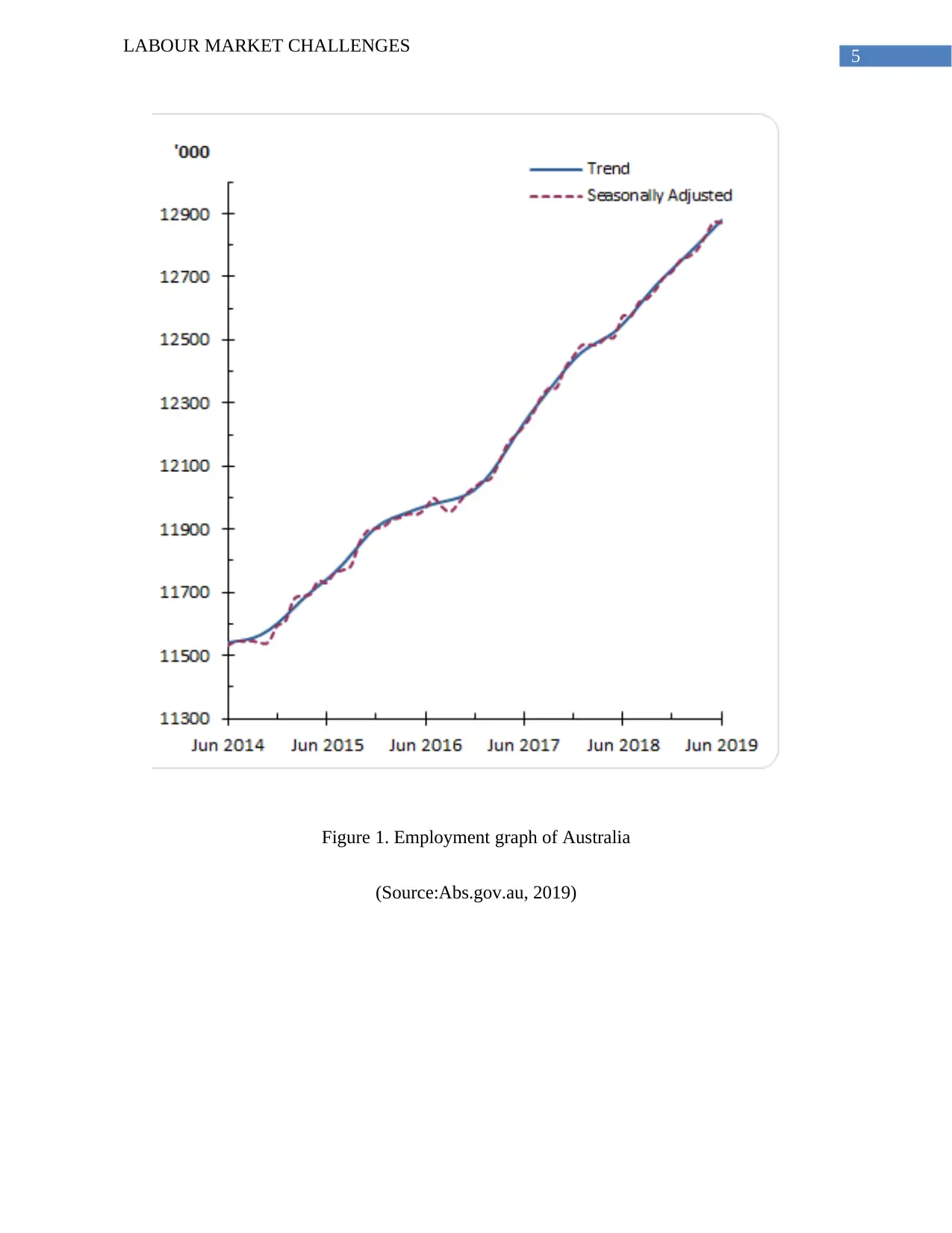
5
LABOUR MARKET CHALLENGES
Figure 1. Employment graph of Australia
(Source:Abs.gov.au, 2019)
LABOUR MARKET CHALLENGES
Figure 1. Employment graph of Australia
(Source:Abs.gov.au, 2019)
⊘ This is a preview!⊘
Do you want full access?
Subscribe today to unlock all pages.

Trusted by 1+ million students worldwide
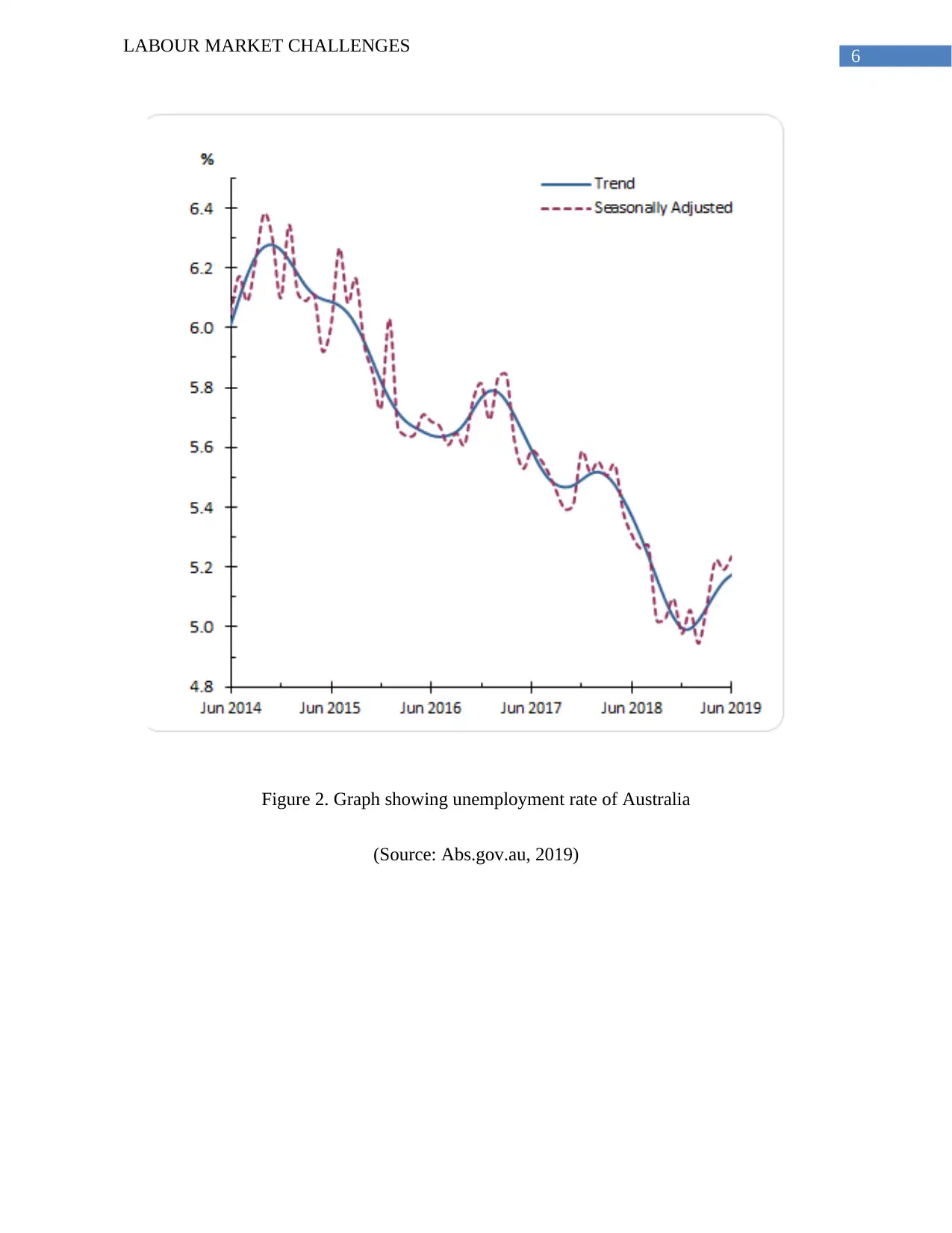
6
LABOUR MARKET CHALLENGES
Figure 2. Graph showing unemployment rate of Australia
(Source: Abs.gov.au, 2019)
LABOUR MARKET CHALLENGES
Figure 2. Graph showing unemployment rate of Australia
(Source: Abs.gov.au, 2019)
Paraphrase This Document
Need a fresh take? Get an instant paraphrase of this document with our AI Paraphraser
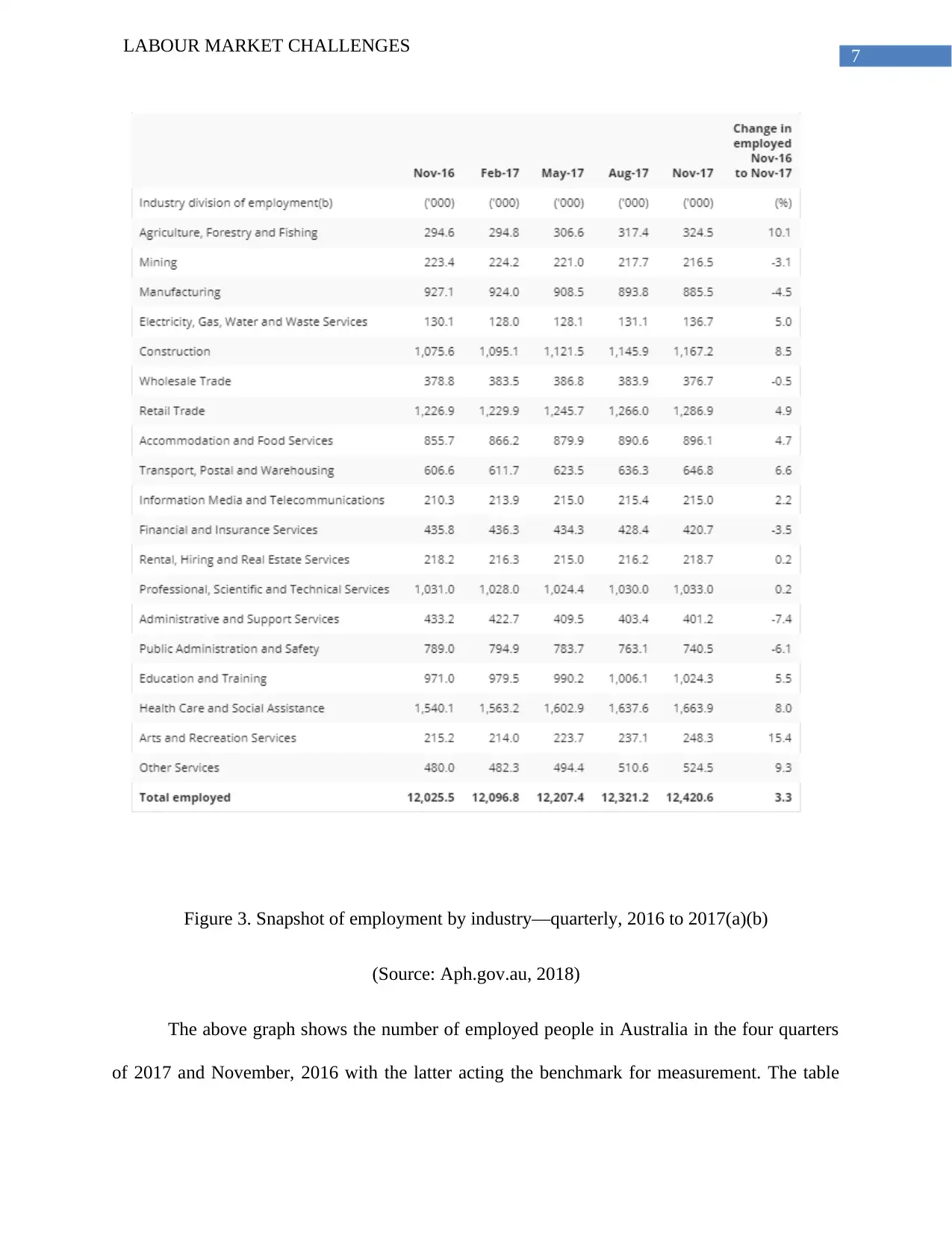
7
LABOUR MARKET CHALLENGES
Figure 3. Snapshot of employment by industry—quarterly, 2016 to 2017(a)(b)
(Source: Aph.gov.au, 2018)
The above graph shows the number of employed people in Australia in the four quarters
of 2017 and November, 2016 with the latter acting the benchmark for measurement. The table
LABOUR MARKET CHALLENGES
Figure 3. Snapshot of employment by industry—quarterly, 2016 to 2017(a)(b)
(Source: Aph.gov.au, 2018)
The above graph shows the number of employed people in Australia in the four quarters
of 2017 and November, 2016 with the latter acting the benchmark for measurement. The table
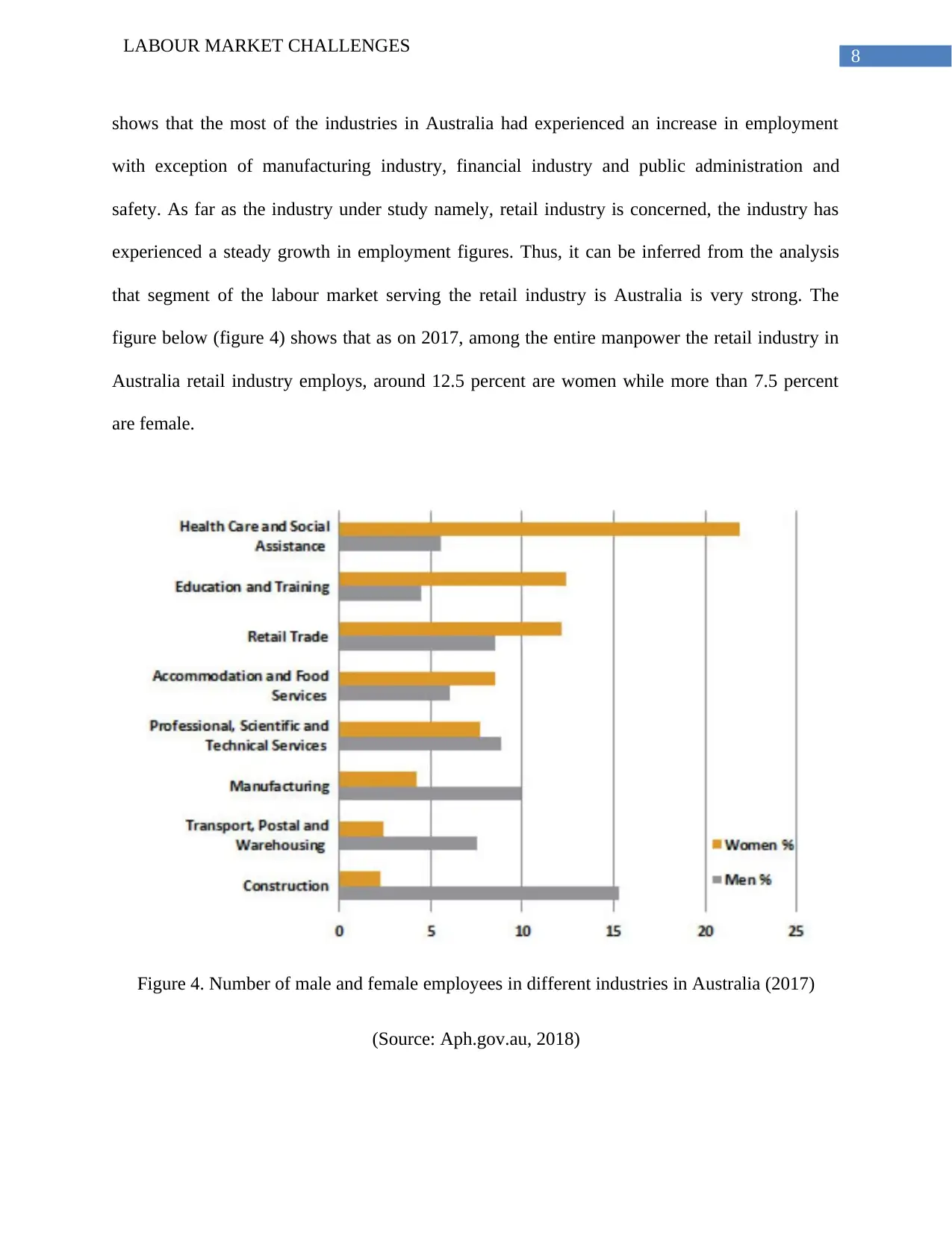
8
LABOUR MARKET CHALLENGES
shows that the most of the industries in Australia had experienced an increase in employment
with exception of manufacturing industry, financial industry and public administration and
safety. As far as the industry under study namely, retail industry is concerned, the industry has
experienced a steady growth in employment figures. Thus, it can be inferred from the analysis
that segment of the labour market serving the retail industry is Australia is very strong. The
figure below (figure 4) shows that as on 2017, among the entire manpower the retail industry in
Australia retail industry employs, around 12.5 percent are women while more than 7.5 percent
are female.
Figure 4. Number of male and female employees in different industries in Australia (2017)
(Source: Aph.gov.au, 2018)
LABOUR MARKET CHALLENGES
shows that the most of the industries in Australia had experienced an increase in employment
with exception of manufacturing industry, financial industry and public administration and
safety. As far as the industry under study namely, retail industry is concerned, the industry has
experienced a steady growth in employment figures. Thus, it can be inferred from the analysis
that segment of the labour market serving the retail industry is Australia is very strong. The
figure below (figure 4) shows that as on 2017, among the entire manpower the retail industry in
Australia retail industry employs, around 12.5 percent are women while more than 7.5 percent
are female.
Figure 4. Number of male and female employees in different industries in Australia (2017)
(Source: Aph.gov.au, 2018)
⊘ This is a preview!⊘
Do you want full access?
Subscribe today to unlock all pages.

Trusted by 1+ million students worldwide
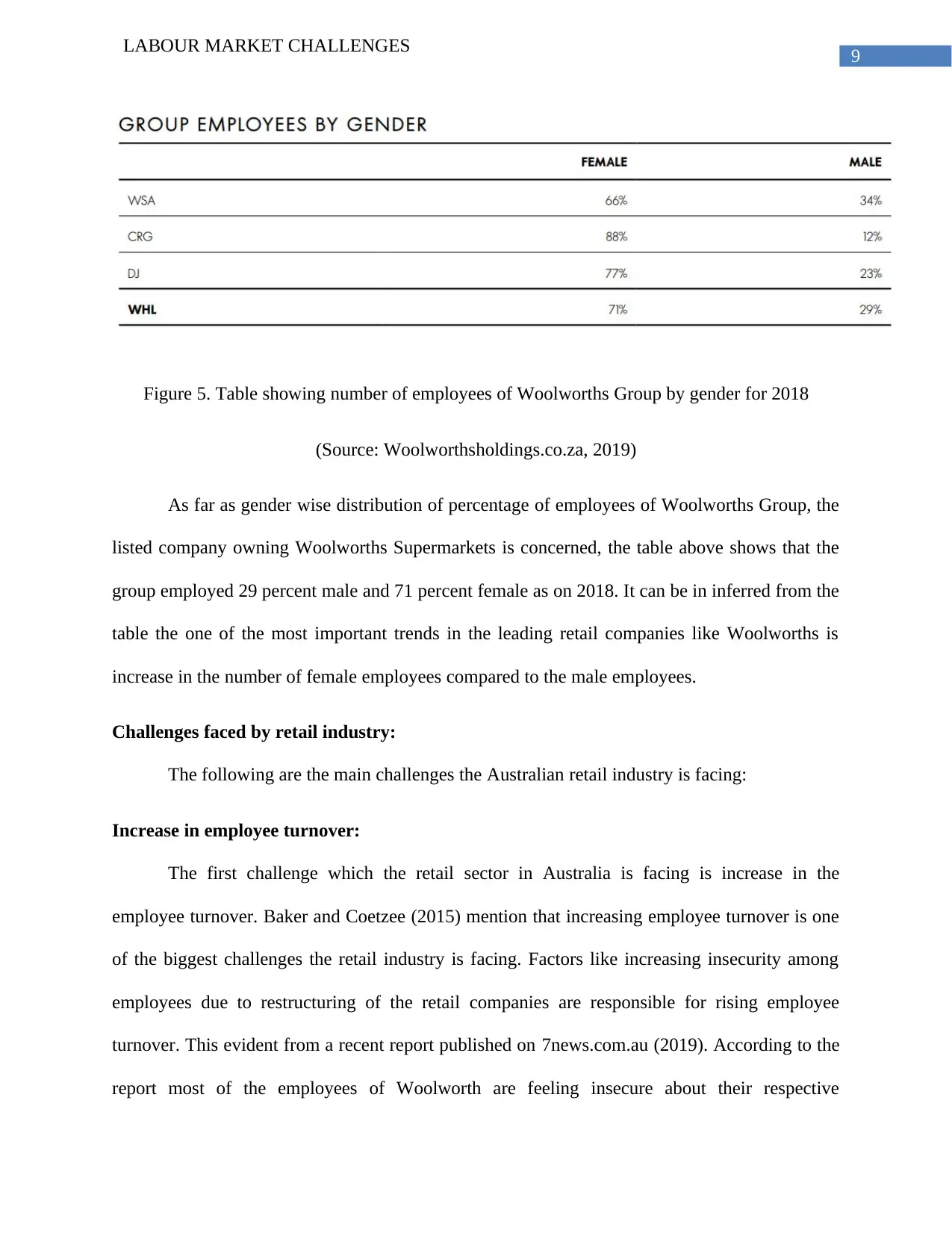
9
LABOUR MARKET CHALLENGES
Figure 5. Table showing number of employees of Woolworths Group by gender for 2018
(Source: Woolworthsholdings.co.za, 2019)
As far as gender wise distribution of percentage of employees of Woolworths Group, the
listed company owning Woolworths Supermarkets is concerned, the table above shows that the
group employed 29 percent male and 71 percent female as on 2018. It can be in inferred from the
table the one of the most important trends in the leading retail companies like Woolworths is
increase in the number of female employees compared to the male employees.
Challenges faced by retail industry:
The following are the main challenges the Australian retail industry is facing:
Increase in employee turnover:
The first challenge which the retail sector in Australia is facing is increase in the
employee turnover. Baker and Coetzee (2015) mention that increasing employee turnover is one
of the biggest challenges the retail industry is facing. Factors like increasing insecurity among
employees due to restructuring of the retail companies are responsible for rising employee
turnover. This evident from a recent report published on 7news.com.au (2019). According to the
report most of the employees of Woolworth are feeling insecure about their respective
LABOUR MARKET CHALLENGES
Figure 5. Table showing number of employees of Woolworths Group by gender for 2018
(Source: Woolworthsholdings.co.za, 2019)
As far as gender wise distribution of percentage of employees of Woolworths Group, the
listed company owning Woolworths Supermarkets is concerned, the table above shows that the
group employed 29 percent male and 71 percent female as on 2018. It can be in inferred from the
table the one of the most important trends in the leading retail companies like Woolworths is
increase in the number of female employees compared to the male employees.
Challenges faced by retail industry:
The following are the main challenges the Australian retail industry is facing:
Increase in employee turnover:
The first challenge which the retail sector in Australia is facing is increase in the
employee turnover. Baker and Coetzee (2015) mention that increasing employee turnover is one
of the biggest challenges the retail industry is facing. Factors like increasing insecurity among
employees due to restructuring of the retail companies are responsible for rising employee
turnover. This evident from a recent report published on 7news.com.au (2019). According to the
report most of the employees of Woolworth are feeling insecure about their respective
Paraphrase This Document
Need a fresh take? Get an instant paraphrase of this document with our AI Paraphraser
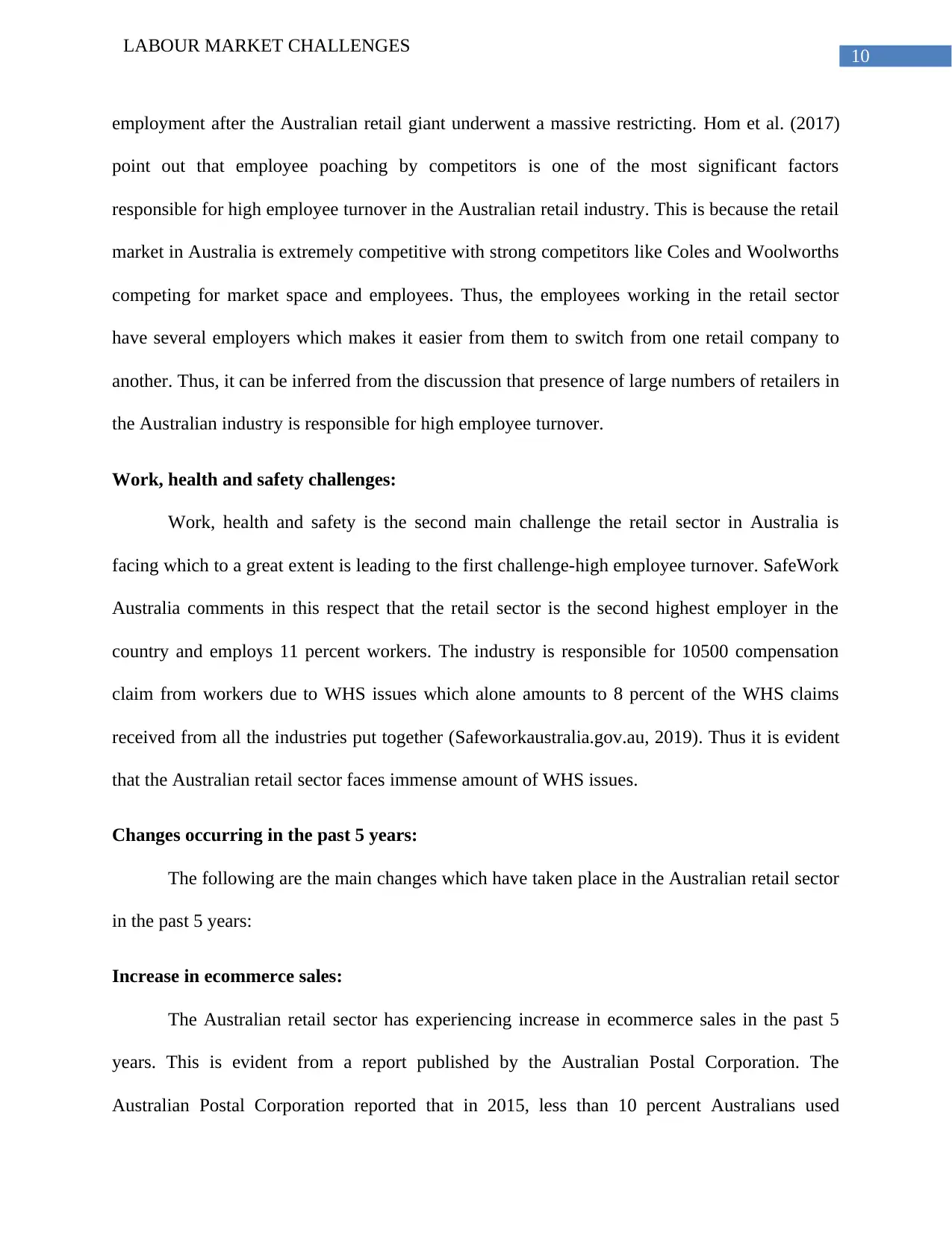
10
LABOUR MARKET CHALLENGES
employment after the Australian retail giant underwent a massive restricting. Hom et al. (2017)
point out that employee poaching by competitors is one of the most significant factors
responsible for high employee turnover in the Australian retail industry. This is because the retail
market in Australia is extremely competitive with strong competitors like Coles and Woolworths
competing for market space and employees. Thus, the employees working in the retail sector
have several employers which makes it easier from them to switch from one retail company to
another. Thus, it can be inferred from the discussion that presence of large numbers of retailers in
the Australian industry is responsible for high employee turnover.
Work, health and safety challenges:
Work, health and safety is the second main challenge the retail sector in Australia is
facing which to a great extent is leading to the first challenge-high employee turnover. SafeWork
Australia comments in this respect that the retail sector is the second highest employer in the
country and employs 11 percent workers. The industry is responsible for 10500 compensation
claim from workers due to WHS issues which alone amounts to 8 percent of the WHS claims
received from all the industries put together (Safeworkaustralia.gov.au, 2019). Thus it is evident
that the Australian retail sector faces immense amount of WHS issues.
Changes occurring in the past 5 years:
The following are the main changes which have taken place in the Australian retail sector
in the past 5 years:
Increase in ecommerce sales:
The Australian retail sector has experiencing increase in ecommerce sales in the past 5
years. This is evident from a report published by the Australian Postal Corporation. The
Australian Postal Corporation reported that in 2015, less than 10 percent Australians used
LABOUR MARKET CHALLENGES
employment after the Australian retail giant underwent a massive restricting. Hom et al. (2017)
point out that employee poaching by competitors is one of the most significant factors
responsible for high employee turnover in the Australian retail industry. This is because the retail
market in Australia is extremely competitive with strong competitors like Coles and Woolworths
competing for market space and employees. Thus, the employees working in the retail sector
have several employers which makes it easier from them to switch from one retail company to
another. Thus, it can be inferred from the discussion that presence of large numbers of retailers in
the Australian industry is responsible for high employee turnover.
Work, health and safety challenges:
Work, health and safety is the second main challenge the retail sector in Australia is
facing which to a great extent is leading to the first challenge-high employee turnover. SafeWork
Australia comments in this respect that the retail sector is the second highest employer in the
country and employs 11 percent workers. The industry is responsible for 10500 compensation
claim from workers due to WHS issues which alone amounts to 8 percent of the WHS claims
received from all the industries put together (Safeworkaustralia.gov.au, 2019). Thus it is evident
that the Australian retail sector faces immense amount of WHS issues.
Changes occurring in the past 5 years:
The following are the main changes which have taken place in the Australian retail sector
in the past 5 years:
Increase in ecommerce sales:
The Australian retail sector has experiencing increase in ecommerce sales in the past 5
years. This is evident from a report published by the Australian Postal Corporation. The
Australian Postal Corporation reported that in 2015, less than 10 percent Australians used
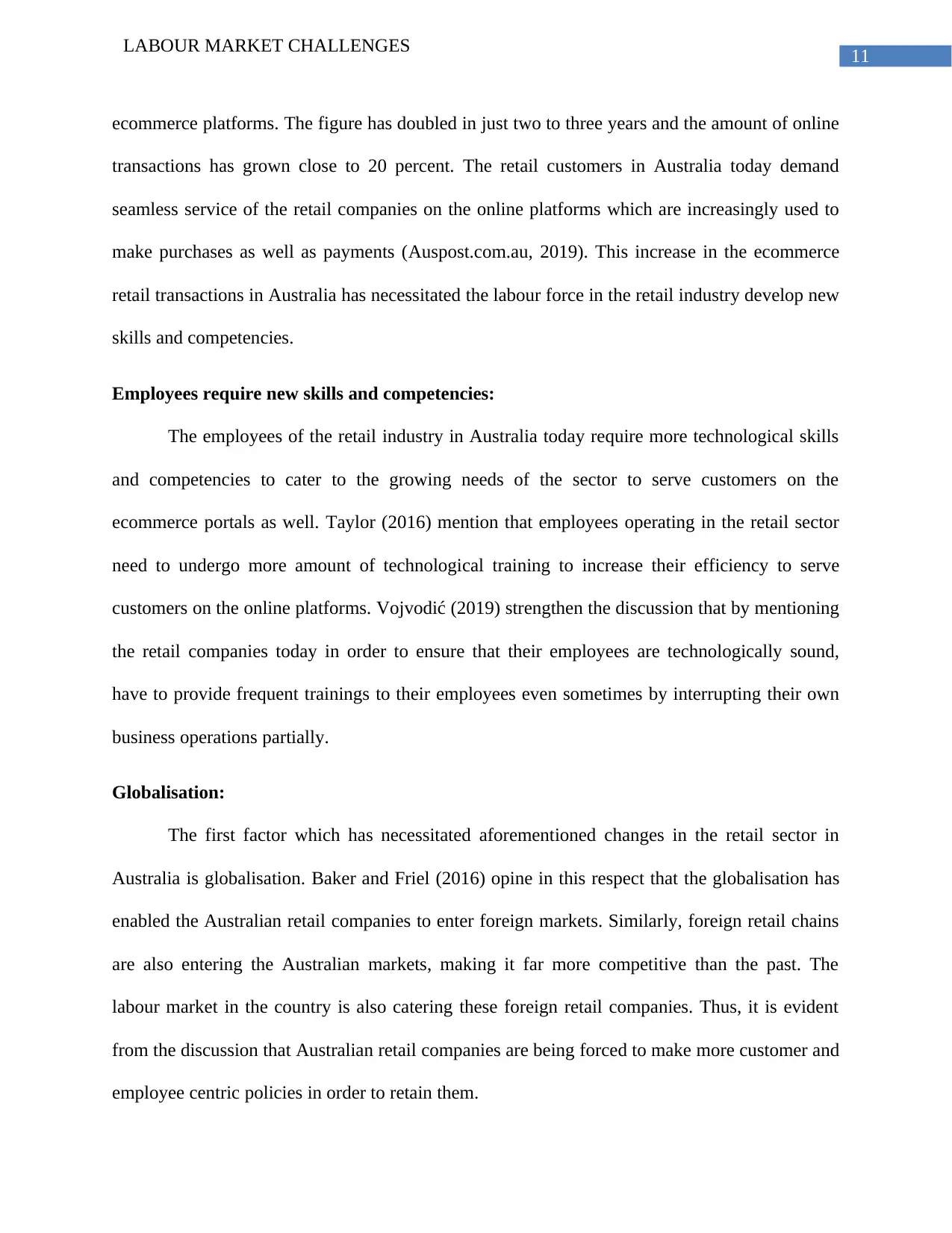
11
LABOUR MARKET CHALLENGES
ecommerce platforms. The figure has doubled in just two to three years and the amount of online
transactions has grown close to 20 percent. The retail customers in Australia today demand
seamless service of the retail companies on the online platforms which are increasingly used to
make purchases as well as payments (Auspost.com.au, 2019). This increase in the ecommerce
retail transactions in Australia has necessitated the labour force in the retail industry develop new
skills and competencies.
Employees require new skills and competencies:
The employees of the retail industry in Australia today require more technological skills
and competencies to cater to the growing needs of the sector to serve customers on the
ecommerce portals as well. Taylor (2016) mention that employees operating in the retail sector
need to undergo more amount of technological training to increase their efficiency to serve
customers on the online platforms. Vojvodić (2019) strengthen the discussion that by mentioning
the retail companies today in order to ensure that their employees are technologically sound,
have to provide frequent trainings to their employees even sometimes by interrupting their own
business operations partially.
Globalisation:
The first factor which has necessitated aforementioned changes in the retail sector in
Australia is globalisation. Baker and Friel (2016) opine in this respect that the globalisation has
enabled the Australian retail companies to enter foreign markets. Similarly, foreign retail chains
are also entering the Australian markets, making it far more competitive than the past. The
labour market in the country is also catering these foreign retail companies. Thus, it is evident
from the discussion that Australian retail companies are being forced to make more customer and
employee centric policies in order to retain them.
LABOUR MARKET CHALLENGES
ecommerce platforms. The figure has doubled in just two to three years and the amount of online
transactions has grown close to 20 percent. The retail customers in Australia today demand
seamless service of the retail companies on the online platforms which are increasingly used to
make purchases as well as payments (Auspost.com.au, 2019). This increase in the ecommerce
retail transactions in Australia has necessitated the labour force in the retail industry develop new
skills and competencies.
Employees require new skills and competencies:
The employees of the retail industry in Australia today require more technological skills
and competencies to cater to the growing needs of the sector to serve customers on the
ecommerce portals as well. Taylor (2016) mention that employees operating in the retail sector
need to undergo more amount of technological training to increase their efficiency to serve
customers on the online platforms. Vojvodić (2019) strengthen the discussion that by mentioning
the retail companies today in order to ensure that their employees are technologically sound,
have to provide frequent trainings to their employees even sometimes by interrupting their own
business operations partially.
Globalisation:
The first factor which has necessitated aforementioned changes in the retail sector in
Australia is globalisation. Baker and Friel (2016) opine in this respect that the globalisation has
enabled the Australian retail companies to enter foreign markets. Similarly, foreign retail chains
are also entering the Australian markets, making it far more competitive than the past. The
labour market in the country is also catering these foreign retail companies. Thus, it is evident
from the discussion that Australian retail companies are being forced to make more customer and
employee centric policies in order to retain them.
⊘ This is a preview!⊘
Do you want full access?
Subscribe today to unlock all pages.

Trusted by 1+ million students worldwide
1 out of 19
Related Documents
Your All-in-One AI-Powered Toolkit for Academic Success.
+13062052269
info@desklib.com
Available 24*7 on WhatsApp / Email
![[object Object]](/_next/static/media/star-bottom.7253800d.svg)
Unlock your academic potential
Copyright © 2020–2025 A2Z Services. All Rights Reserved. Developed and managed by ZUCOL.





